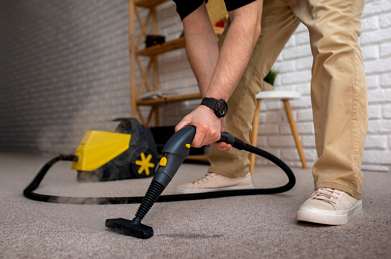Maintaining a clean living environment is essential for our health and well-being. Carpets are significant among the many components that contribute to a healthy home. However, carpets can become breeding grounds for dust, allergens, and other pollutants, affecting indoor air quality and potentially impacting our health. Understanding how carpet cleaning influences indoor air quality and overall health is crucial in creating a safer and healthier living space.
The Relationship Between Carpets and Indoor Air Quality
The connection between carpets and indoor air quality (IAQ) is intricate and vital for maintaining a healthy indoor environment. Carpets play a multifaceted role in the overall quality of the air within our homes.
1. Filtration of Airborne Particles:
Carpets function as giant filters within indoor spaces. When air circulates, carpets trap airborne particles such as dust, dirt, pollen, pet dander, and other contaminants. This initial filtration capacity contributes positively to indoor air quality by preventing these particles from freely circulating in the air we breathe.
2. Accumulation of Contaminants:
Despite their filtering role, carpets are limited: they can only hold a certain amount of debris. Over time, carpets accumulate an impressive array of contaminants, especially in high-traffic areas. Even with regular vacuuming, some particles embed deeply into the carpet fibres, creating a reservoir of potential allergens and pollutants.
3. Allergens and Irritants Trapped in Carpets:
For individuals with allergies or respiratory issues, carpets can pose challenges. Allergens like dust mites, pet dander, and pollen can get trapped in the carpet, potentially triggering allergic reactions or respiratory problems. Vacuuming alone might not effectively remove these allergens lodged deep within the fibres.
4. Emission of Volatile Organic Compounds (VOCs):
New carpets, adhesives used during installation, or treatments for stain resistance or colour can emit volatile organic compounds (VOCs) into the indoor air. VOCs, such as formaldehyde and benzene, contribute to indoor air pollution and can cause health issues, especially for sensitive individuals.
5. Moisture Retention and Mold Growth:
Carpets can retain moisture from spills, tracked-in water, or high humidity. This moisture becomes a breeding ground for mould, mildew, and bacteria. Mold growth damages the carpet and poses health risks, particularly for those prone to respiratory illnesses.
6. Impact on Overall Air Quality:
While carpets initially assist in capturing airborne particles, their efficacy decreases as they accumulate contaminants. If left unattended, carpets can transition from helpful air filters to potential sources of indoor air pollution.
Understanding this relationship underscores the importance of proactive carpet care. Regular maintenance, effective cleaning methods, and preventive measures can significantly mitigate the impact of carpets on indoor air quality.
Role of Carpet Cleaning in Improving Indoor Air Quality
Professional carpet cleaning serves as a powerful tool in combating indoor air pollution. It employs hot water extraction, steam cleaning, and dry cleaning to eliminate deep-seated contaminants that regular vacuuming can’t reach.
Removal of Allergens: Professional cleaning effectively removes allergens trapped in carpets, reducing the triggers for allergic reactions and asthma.
Elimination of Dust Mites: Dust mites, a common allergen, thrive in carpets. Thorough cleaning helps eliminate these microscopic pests, preventing potential health issues.
Bacteria and Mold Removal: Moisture, often trapped within carpets, can lead to the growth of bacteria and mould. Professional cleaning eradicates these threats, ensuring a healthier indoor environment.
Moreover, using specialised cleaning solutions and equipment ensures deeper cleaning without leaving behind harmful residues, further contributing to improved indoor air quality.
Choosing the Right Carpet Cleaning Method
Different carpet cleaning methods offer distinct advantages regarding effectiveness and impact on indoor air quality.
Steam Cleaning: This method employs hot water and steam to penetrate deep into carpet fibres, effectively removing dirt, allergens, and bacteria. It’s known for its ability to sanitise without harsh chemicals.
Dry Cleaning: Utilizing minimal moisture, dry cleaning methods, such as encapsulation, use specialised compounds to encapsulate dirt, allowing easy removal without excessive water.
Hot Water Extraction: Deep cleaning involves injecting hot water and a cleaning solution into the carpet at high pressure and then extracting it with loosened debris. It’s highly effective in removing stubborn stains and deep-seated contaminants.
Frequency of Carpet Cleaning for Optimal Indoor Air Quality
Determining the frequency of carpet cleaning for optimal indoor air quality involves considering factors like foot traffic, environmental conditions, and the presence of allergens or pollutants. Here’s an in-depth look at how these elements influence the recommended frequency of carpet cleaning:
1. Foot Traffic and Usage:
Areas with high foot traffic, such as living rooms, hallways, or commercial spaces, accumulate dirt, dust, and other debris more rapidly. More frequent cleaning is necessary in these areas to maintain the carpet’s appearance and its ability to contribute to good indoor air quality. High-traffic areas require cleaning every 6 to 12 months.
2. Environmental Factors:
Environmental conditions play a significant role in carpet cleanliness. Homes in dusty or polluted areas or those with high humidity levels might require more frequent cleaning. Dust and pollutants can accumulate faster, affecting the carpet’s cleanliness and the indoor air quality. Additionally, areas prone to spills or moisture need prompt attention to prevent mould or mildew growth, which can affect air quality.
3. Allergens and Health Concerns:
Maintaining clean carpets is crucial for households with residents sensitive to allergens or prone to respiratory issues. Individuals with allergies or asthma might require more frequent cleaning to minimise exposure to allergens like dust mites, pet dander, or pollen trapped in the carpet fibres. Cleaning every 3 to 6 months might be advisable for such households.
4. Pets and Additional Factors:
Homes with pets tend to accumulate more pet hair and dander in carpets. Regular vacuuming helps, but professional cleaning every 6 to 12 months, or more frequently as needed, is often recommended to address pet-related allergens and odours.
5. Manufacturer Recommendations:
Some carpet warranties specify a required frequency for professional cleaning to maintain the warranty. Adhering to these guidelines ensures the carpet remains in optimal condition, contributing to improved indoor air quality.
DIY Carpet Cleaning vs. Professional Services
While DIY carpet cleaning methods exist, they often need more efficacy than professional services. Consumer-grade carpet cleaners might not be able to effectively remove embedded contaminants, potentially leaving residues and moisture behind, which could further exacerbate indoor air quality issues.
On the other hand, professional services with reputed companies in Melbourne like Wizard Cleaning utilise advanced equipment, techniques, and certified cleaning agents, ensuring a thorough and safe cleaning process that promotes better indoor air quality and overall health.
Conclusion
In conclusion, the impact of carpet cleaning on indoor air quality and health is undeniable. Regular professional cleaning removes visible stains and eliminates hidden contaminants, allergens, and pollutants affecting our well-being. Investing in proper carpet maintenance creates a healthier indoor environment, reducing the risks associated with poor air quality and enhancing the quality of life for ourselves and our families.
By understanding the significance of carpet cleaning in maintaining optimal indoor air quality, we take a proactive step towards ensuring a healthier and more comfortable living space for everyone.

